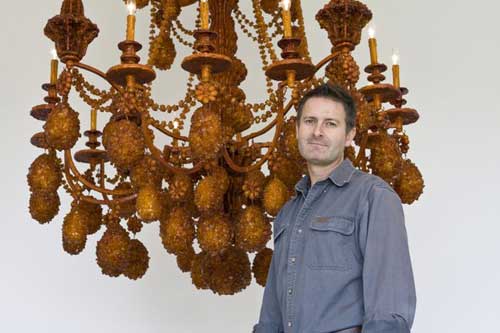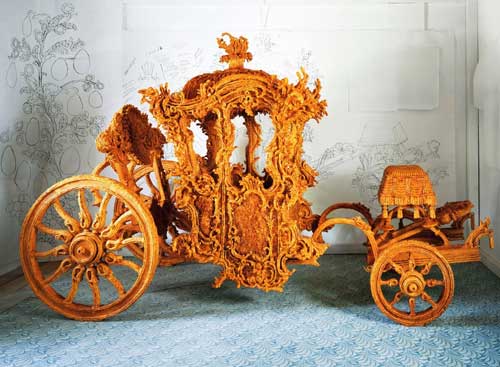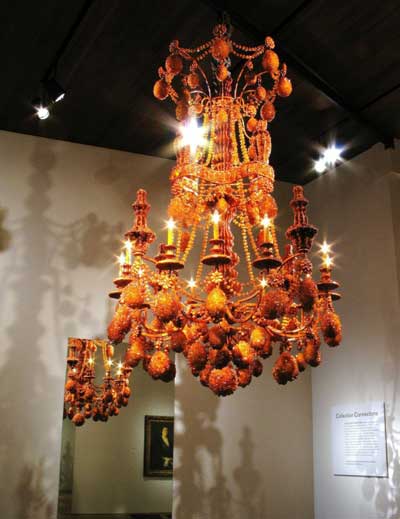
 Sculpture News at SculptSite.com
Sculpture News at SculptSite.com
Timothy Horn Sculpture |
| KPBS BY ANGELA CARONE Timothy Horn's Ornate And Sweet SculptureThere are certain dilemmas peculiar to artists. To wit: one has built a child-size, Cinderella-esque horse carriage out of plywood, steel and crystallized rock sugar (!) and needs to transport it from Boston to San Francisco for an exhibit. This was the dilemma facing Australian sculptor Timothy Horn two years ago when his show "Bitter Suite" was set to open at San Francisco's de Young Museum. Horn is the new artist-in-residence at Lux Art Institute in Encinitas where the aforementioned carriage, titled "Mother-Load," is now on view. Getting the carriage to San Diego was no problem, but that first cross country trip was nerve-wracking. Horn built the structure so he could dismantle and fit it into 30 boxes for transport by truck. The dilemma stemmed from the crystallized rock sugar affixed to the entire carriage. "I was concerned about how hot the truck would get and worried the piece would just melt... I thought I'd find a truck floor glazed with toffee." Thankfully, when they arrived in SF, Horn found the sweet coating completely in tact. For Horn, this remains a source of pride: "When we got there, not one crumb of sugar was on the truck floor!" Horn likes to experiment with materials. He's worked with glass, metal, and rubber. His foray into sugar was inspired by the rags-to-riches story of Alma le Normand de Bretteville Spreckels, wife of San Francisco sugar baron Adolph Spreckels, who Horn calls "the original sugar daddy." When Horn first toured the fine art collection at the Legion of Honor (in San Francisco), he became enamored with Alma's story. Alma Spreckels was born into a poor family, worked as a nude model, and eventually caught the eye of the much older Adolph. The two married and Alma struggled to find acceptance in San Francisco high society. She began collecting art, especially ancient art and works from Europe. Alma eventually founded and gifted the Legion of Honor to San Francisco, furnishing the museum with her collection. Horn's use of sugar on "Mother-Load" and the other sculpture in "Bitter Suite," a rococo-style chandelier titled "Diadem" (also on view at Lux), is a nod to the sugar baroness. Alma also owned a gilded Neopolitan sedan chair that became an early inspiration for "Mother-Load, and which she supposedly used as a telephone booth in her Pacific Heights mansion. Alma was also rumored to ride around in her sedan chair every Christmas, "carried through the streets of San Francisco by four strapping lads to do her shopping." For Horn, Alma Spreckels shares muse status with another woman who fought for respect, Catherine the Great. Horn explains, "Catherine the Great and Alma Spreckels are two women who really rose above the hurdles and adversities of their lives. It was a period when it was really difficult for women to retain power and keep it. They were both survivors." The amber color of both "Mother-Load" and "Diadem" reference Catherine the Great's famous Amber Room. The sculptures' rich coloring is the result of amber shellac that serves as a sealant. "Mother-Load" is obscenely ornate. It has rococo ornamentation, scrolling, a tassled driver's seat, and a passenger stool boasting rock size sugar crystals (see photos in the gallery above). To achieve the ornamentation, Horn scrunched up tin foil into sausage shapes and hot glued them to the sculpture's armature, made out of plywood. He then painted the entire structure with gesso and applied the sugar with an acrylic gel medium. Needless to say, a lot of sugar was required. "I went to a large Asian grocery story in Albuquerque and they sell bags of crystallized rock sugar which is used in the production of brandy and other bootleg alcohol. I filled four shopping carts full of sugar. The woman at the check out said, 'Hmmm, doing some baking are you?'" Horn had never worked with sugar before, but the 18th century tradition of using sugar for elaborate table centerpieces fit with Horn's interest in the decorative arts of the period. 18th century artists and designers often used faux products in place of genuine precious stones and materials, a practice Horn mimics. "There was this kind of trick going on and I really like to exploit this in my work as well. " Exploit it he does, and not always with sugar. For a wall piece inspired by an 18th century jewelry pattern, Horn makes diamonds out of cast crystal and then backs them with colored Easter egg foil so they pop. He even made an elaborate Chippendale patterned mirror out of transparent rubber. These "tricks" as Horn calls them, hold the pleasure of the unexpected.With his obsessive and detailed attention to craft, each sculpture both is and isn't the thing it represents. It is the use of the unexpected material - the trick - that creates a fantastical quality around each piece. The aesthetic language used in the carriage and the chandelier are familiar and iconic - that of the 17th and 18th centuries, when baroque developed and then flowered into rococo. But the odd material allows the viewer to reconsider the familiar decorative elements, while also highlighting each material's unique qualities, like sugar's granularity. Horn stands on a ladder hanging sugar-encrusted baubles onto his chandelier. When asked what it is about the baroque that interests him, he replies, "It's a language I understand." And looking up into the sweet, ornate playfulness of "Diadem," that's abundantly clear. Timothy Horn's work will be on view at the Lux Art Institute in Encinitas through October 30th and Horn will be working in the studio through October 9th. This evening is the first Lux@Night of the 2010/2011 Season. Timothy Horn will be there, and there will be a special performance by the Luke-8-Tia Duo. Lux@Night is free and begins at 7pm. |
 What did the Great One (Jackie Gleason) say? "How Sweet It Is". You can sure say that about Timothy Horn's ornate rococo ornamentation that he utilizes in his work. A great story in Alma Spreckels wife of a sugar baron. Very intersting work! It seems to grow on you... I know this, if I were anywhere near the Lux Art Institute in Encinitas I would nmake a point to see Timothy's work. |
 "Diadem" by Tomothy Horn |
 "Mother Load" by Tomothy Horn |
 "Diadem" at Young Museum, San Francisco |
More Sculpture News ....
Submit your SCULPTURE NEWS.
It's easy, just send us an e-mail
(click on Submit News in the left menu) with your pertinent information along with images, we'll take care of the rest. Sculpture makes our world a much better place in so many ways!
SculptSite.com, along with Sculptors and their creative genius all helping to bring the beauty and message of Sculpture to a hurried world.

